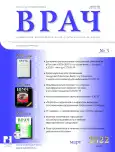ANTIBACTERIAL PROPERTIES OF THE CHEMOKINE CXCL9
- 作者: Bidzhiev A.Z1, Kraeva L.A1,2, Burgasova O.A3,4
-
隶属关系:
- Pasteur Research Institute of Epidemiology and Microbiology
- S.M. Kirov Military Medical Academy
- Peoples’ Friendship University of Russia
- N.F. Gamaleya National Research Center for Epidemiology and Microbiology
- 期: 卷 33, 编号 3 (2022)
- 页面: 47-50
- 栏目: Articles
- URL: https://journals.eco-vector.com/0236-3054/article/view/114604
- DOI: https://doi.org/10.29296/25877305-2022-03-09
- ID: 114604
如何引用文章
详细
In recent years, there has been an unprecedented increase in the resistance of bacterial strains to antibiotics. Millions of deaths per year are recorded worldwide due to the spread of antibiotic-resistant strains. However, in the human body there is a little-studied natural system of counteracting microorganisms - chemokines. To investigate the antibacterial properties of the chemokine CXCL9. The conducted study revealed the antibacterial effect of the CXCL9 chemokine on clinically significant bacterial species (Klebsiella pneumoniae, Pseudomonas aeruginosa, Staphylococcus aureus, Streptococcus agalactiae, Corynebacterium diphtheriae, and Listeria monocytogenes). A bactericidal stable activity against the bacteria Listeria monocytogenes was noted within 7 hours after contact with the chemokine CXCL9. The findings demonstrated the presence of antibacterial properties of the chemokine CXCL9 in relation to a number of microorganisms with the different structure of the cell wall.
全文:
作者简介
A. Bidzhiev
Pasteur Research Institute of Epidemiology and Microbiology
Email: olgaburgasova@mail.ru
L. Kraeva
Pasteur Research Institute of Epidemiology and Microbiology; S.M. Kirov Military Medical Academy
编辑信件的主要联系方式.
Email: olgaburgasova@mail.ru
доктор медицинских наук.
O. Burgasova
Peoples’ Friendship University of Russia; N.F. Gamaleya National Research Center for Epidemiology and Microbiology
Email: olgaburgasova@mail.ru
参考
- Naveed M., Chaudhry Z., Bukhari S. A. et al. Antibiotics resistance mechanism. In: Antibiotics and Antimicrobial Resistance Genes in the Environment. Elsevier, 2020; р. 292-312.
- Zlotnik A. Perspective: Insights on the Nomenclature of Cytokines and Chemokines. Front Immunol. 2020; 11: 908. doi: 10.3389/fimmu.2020.00908
- Murphy P.M., Baggiolini M., Charo I.F. et al.International union of pharmacology. XXII. Nomenclature for chemokine receptors. Pharmacol Rev. 2000; 52 (1): 145-76.
- Chensue S.W. Molecular machinations: chemokine signals in host-pathogen interactions. Clin Microbiol Rev. 2001; 14 (4): 821-35. doi: 10.1128/CMR.14.4.821-835.2001
- Mehrad B., Keane M.P., Strieter R.M. Chemokines as mediators of angiogenesis. Thromb Haemost. 2007; 97 (5): 755-62.
- Raman D., Baugher P.J., Thu Y.M. et al. Role of chemokines in tumor growth. Cancer Lett. 2007; 256 (2): 137-65. doi: 10.1016/j.canlet.2007.05.013
- Crawford M.A., Burdick M.D., Glomski I.J. et al.Interferon-inducible CXC chemokines directly contribute to host defense against inhalational anthrax in a murine model of infection. PLoS Pathog. 2010; 6 (11): e1001199. doi: 10.1371/journal.ppat.1001199
- Egesten A., Eliasson M., Johansson H.M. et al. The CXC chemokine MIG/CXCL9 is important in innate immunity against Streptococcus pyogenes. J Infect Dis. 2007; 195 (5): 684-93. doi: 10.1086/510857
- Balogh E.P., Faludi I., Virok D.P. et al. Chlamydophila pneumoniae induces production of the defensin-like MIG/CXCL9, which has in vitro antichlamydial activity.Int J Med Microbiol. 2011; 301 (3): 252-9. doi: 10.1016/j.ijmm.2010.08.020
- Crawford M.A., Fisher D.J., Leung L.M. et al. CXC Chemokines Exhibit Bactericidal Activity against Multidrug-Resistant Gram-Negative Pathogens. mBio. 2017; 8 (6): e01549-17. doi: 10.1128/mBio.01549-17
- Yung S.C., Murphy P.M. Antimicrobial chemokines. Front Immunol. 2012; 3: 276. doi: 10.3389/fimmu.2012.00276
- Crawford M.A., Margulieux K.R., Singh A. et al. Mechanistic insights and therapeutic opportunities of antimicrobial chemokines. Semin Cell Dev Biol. 2019; 88: 119-28. doi: 10.1016/j.semcdb.2018.02.003
- Sobirk S.K., Morgelin M., Egesten A. et al. Human chemokines as antimicrobial peptides with direct parasiticidal effect on Leishmania mexicana in vitro. PLoS One. 2013; 8 (3): e58129. doi: 10.1371/journal.pone.0058129
- Cole A.M., Ganz T., Liese A.M. et al. Cutting edge: IFN-inducible ELR-CXC chemokines display defensin-like antimicrobial activity. J Immunol. 2001; 167 (2): 623-7. DOI: 10.4049/ jimmunol.167.2.623
- Yang D., Chen Q., Hoover D.M. et al. Many chemokines including CCL20/MIP-3alpha display antimicrobial activity. J Leukoc Biol. 2003; 74 (3): 448-55. doi: 10.1189/jlb.0103024
- Frick I.M., Nordin S.L., Baumgarten M. et al. Constitutive and inflammation-dependent antimicrobial peptides produced by epithelium are differentially processed and inactivated by the commensal Finegoldia magna and the pathogen Streptococcus pyogenes. J Immunol. 2011; 187 (8): 4300-9. doi: 10.4049/jimmunol.1004179
- Burkhardt A.M., Tai K.P., Flores-Guiterrez J.P. et al. CXCL17 is a mucosal chemokine elevated in idiopathic pulmonary fibrosis that exhibits broad antimicrobial activity. J Immunol. 2012; 188 (12): 6399-406. doi: 10.4049/jimmunol.1102903
- Linge H.M., Collin M., Nordenfelt P. et al. The human CXC chemokine granulocyte chemotactic protein 2 (GCP-2)/CXCL6 possesses membrane-disrupting properties and is antibacterial. Antimicrob Agents Chemother. 2008; 52 (7): 2599-607. DOI: 10.1128/ AAC.00028-08
- Kotarsky K., Sitnik K.M., Stenstad H. et al. A novel role for constitutively expressed epithelial-derived chemokines as antibacterial peptides in the intestinal mucosa. Mucosal Immunol. 2010; 3 (1): 40-8. doi: 10.1038/mi.2009.115
补充文件





